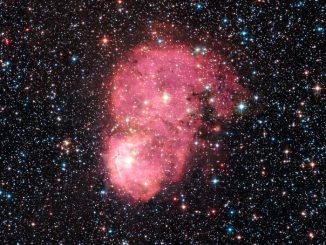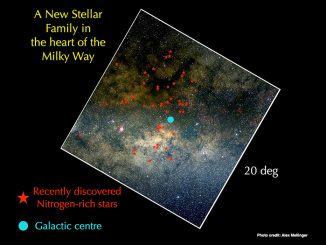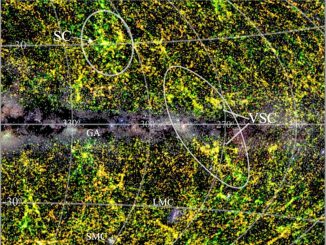
Milky Way


Our galaxy’s black hole is spewing out planet-size ‘spitballs’
Every few thousand years, an unlucky star wanders too close to the black hole at the center of the Milky Way. The black hole’s powerful gravity rips the star apart, sending a long streamer of gas whipping outward. That would seem to be the end of the story, but it’s not. New research shows that not only can the gas gather itself into planet-size objects, but those objects then are flung throughout the galaxy in a game of cosmic “spitball.”




Hubble spotlights irregular galaxy IC 3583
This NASA/ESA Hubble Space Telescope image reveals a delicate blue group of stars — actually an irregular galaxy named IC 3583 — that sits some 30 million light-years away in the constellation of Virgo. This small galaxy is thought to be gravitationally interacting with one of its neighbours, the spiral Messier 90.

Newly discovered stars shed light on Milky Way’s formation
An astronomer from Liverpool John Moores University has discovered a new family of stars in the core of the Milky Way which provides new insights into the early stages of the galaxy’s formation. The discovery has shed new light on the origins of globular clusters formed at the beginning of the Milky Way’s history.

Record-breaking dwarf satellite galaxy of the Milky Way discovered
An international team has found an extremely faint dwarf satellite galaxy of the Milky Way using the Hyper Suprime-Cam (HSC) on the 8.2-metre Subaru Telescope located at the Mauna Kea Observatory on Hawaii. Named Virgo I, the galaxy lies 280,000 light-years away in the constellation of Virgo. The galaxy may well be the faintest satellite galaxy yet found.

Major supercluster of galaxies found hidden by the Milky Way
An international team of astronomers has discovered a previously unknown major concentration of galaxies in the constellation Vela, which they have dubbed the Vela supercluster. The gravitational attraction from this large mass concentration in our cosmic neighbourhood may have an important effect on the motion of our Local Group of galaxies.

New theory of gravity might explain dark matter
Emergent gravity is a new theory that might explain the curious motions of stars in galaxies. It predicts the exact same deviation of motions that is usually explained by invoking dark matter. Professor Erik Verlinde, renowned expert in string theory, publishes a new research paper today in which he expands his groundbreaking views on the nature of gravity.
